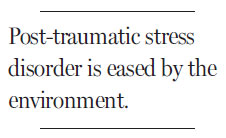A focus on what follows trauma
Updated: 2013-01-06 11:57
By David Dobbs(The New York Times)
|
|||||||


Psychological trauma dims tens of millions of lives around the world and helps create costs of at least $42 billion a year in the United States alone. But what is trauma, exactly?
Culturally and medically, we have long seen it as arising from a single, identifiable disruption. Witness a shattering event, or fall victim to it - and as the poet Walter de la Mare put it, "the human brain works slowly: first the blow, hours afterward the bruise." The world returns more or less to normal, but you do not.
In 1980, the Diagnostic and Statistical Manual of Mental Disorders defined trauma as "a recognizable stressor that would evoke significant symptoms of distress in almost everyone" - universally toxic, like a poison.
But it turns out that most trauma victims - even survivors of combat, torture or concentration camps - rebound to live full, normal lives. That has given rise to a more nuanced view of trauma as less a poison than an infectious agent, a challenge that most people overcome but that may defeat those weakened by past traumas or other factors.
New research suggests that the environment just after the event, particularly other people's responses, may be as crucial as the event itself. Two presentations this fall at the Interdisciplinary Conference on Culture, Mind and Brain at the University of California, Los Angeles, demonstrated the idea.
Paul Plotsky, a neurobiologist at Emory University in Atlanta, described what happened when he changed a model of how maternal separation affects rats.
Earlier experiments kept mother and pups apart from one to 24 hours; Dr. Plotsky reset those periods to 15 minutes (the amount of time rat mothers in the wild routinely leave their litters to get food) and 180 minutes (a traumatic separation, he says, because it would mean that the mother had come to harm).
After a 15-minute separation, a mother would typically sniff and lick each pup, then gather and feed them. After a 180-minute separation, however, most mothers would emit panicky squeaks, often stomping on or ignoring the pups. The pups too would squeak loudly. And for the rest of their lives, they had outsize reactions to stress.
Studies showed that long separations created anxious rodents with permanent changes in stress-hormone activity, brain structure and other measures.
But about five years ago, Dr. Plotsky was thinking about the mother's post-separation panic when, he said, "it hit me: maybe she views her environment as unsafe" because it was the same place she and her pups were taken from.
He upgraded to an eight-room cage. Then, even after 180-minute separations, things went fine. The mother would sniff the pups, check out a couple of rooms, then move everybody to one of them and coddle and nurse the pups.
Few pups showed any signs of trauma, immediate or lasting. A separation that had been considered permanently scarring proved routine simply because the mother, having a more varied, secure environment in which to receive her pups, felt calmer and more in control, and she passed that on to the pups. Trauma seemed now to rise not from the separation but from the flavor of the reunion.
A study of former child soldiers in Nepal suggests that may hold true for humans. Dr. Brandon Kohrt at George Washington University in Washington, D.C., has followed Nepalese children who returned to their villages after serving with the Maoist rebels during the 1996-2006 civil war.
All 141 in the study, 5 to 14 years old when they joined the rebels, experienced events considered traumatic, yet their postwar mental health depended on how their families and villages received them.
In villages where the children were stigmatized or ostracized, they suffered high, persistent levels of post-traumatic stress disorder.
But in villages where they were readily and happily reintegrated, they experienced no more mental distress than did peers who had never gone to war. The lasting harm of being a child soldier, it seemed, arose not from the war but from social isolation and conflict afterward.
Carol Ryff, a psychologist at the University of Wisconsin who does research on resilience, says the findings confirmed that "certain conditions maximize the likelihood of alleviating trauma."
But others, like the neuroscientist and writer Sandra Aamodt, say the studies suggest that there is no trauma to alleviate until the post-event social environment plays its role. To Dr. Plotsky, this new view strengthens the argument for social interventions that have been shown to ease the effects of traumatic experiences - especially preschool programs for children at risk of trauma, and training for their parents.
It seems as if we can't undo bad things that happen, but maybe we can reshape the environment that exists in their wake. As Dr. Aamodt puts it, that approach "has the significant advantage of being possible."
The New York Times
(China Daily 01/06/2013 page9)